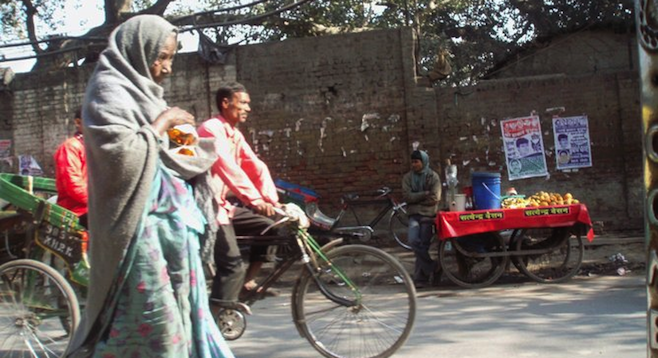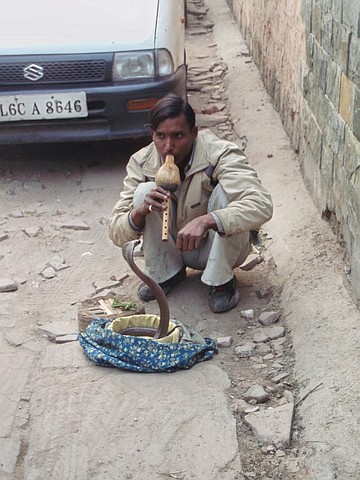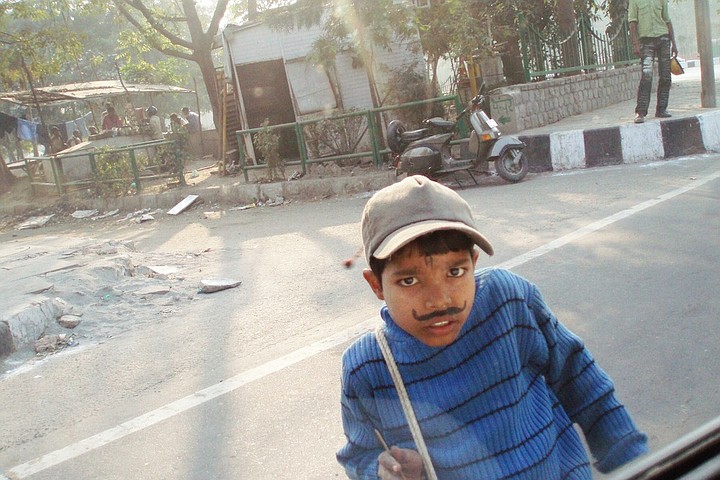 Facebook
Facebook
 X
X
 Instagram
Instagram
 TikTok
TikTok
 Youtube
Youtube

A visit to India as an independent solo traveler is a unique challenge mentally, physically and logistically.
I arrived in Delhi in the middle of the night, worked my way through the bustling crowd, and managed to find my driver holding up a sign with “Derek Ray” written in block letters. I had arranged for a driver in advance to avoid the local scam I'd read about in which taxi drivers try to divert the just-arrived visitor to a different hotel than the one requested, claiming their reserved hotel is closed. This allows the scammer to collect a commission.
I didn’t know how widespread this was, but decided I didn’t want to take any chances with my jet lag. I wanted my middle-of-the-night arrival in this most exotic of destinations to be a smooth one.
“I am not a rich man,” my driver remarked, perhaps incorrectly assuming that I, having just arrived from halfway around the world with my milky white skin, was. I left him a nice tip.
When I arrived at my hotel, the Ajanta, it appeared quite different than the photos on their website – a bit more, well, shabby. The discrepancy was not of the Exotic Marigold Hotel extreme (there were no birds in the room), but it was notable. I managed, nevertheless, to push this out of my mind and quickly fall into a deep sleep.
Early the next morning, I was awoken by the incessant beeping of cars in the street below – a sound that would be omnipresent throughout my stay. Drivers in Delhi honk their horns to alert you of their presence, but there's seemingly little road rage. I actually came to feel a strange affection for the cacophony. Even today, when I hear a guy leaning on his horn it brings me back to my days in Delhi.

Walking Delhi's streets, I was unprepared for the amount and intensity of attention I would receive. I was approached by aggressive hawkers, mothers with small children pleading for a few rupees, and kids all about watching for an opportunity from a sympathetic visitor. A group of boys came up and repeated the one word in English they seemed to know best: “money.” I took their picture and showed it to them, to their amusement and delight.
Despite these annoyances, walking is also the best way to get to know the locals. I became engaged in small conversation with random people on the street fascinated to meet an American. A few Indian kids even invited me to join their cricket game. I was also invited for a cup of chai and offered a rickshaw ride to an “excellent place.”
Between all the pleas for money and various offers, spontaneous decisions can be exhausting unless you just say no to everything. But in my book, that’s no way to learn anything new. I decided to say yes to the cup of chai. After I became comfortable with my chai partner, I said yes to a rickshaw ride. Call me crazy, but life's an adventure.
The rickshaw ride was a harrowing but exhilarating experience; my driver either skillfully or recklessly (I wasn’t sure which) maneuvered through the swirl of traffic encircling Connaught Place in the heart of Delhi.

I was brought by my new friend to his favorite restaurant and then to a tea shop. As I exited the tea shop, my attention was immediately captured by a snake charmer manipulating a cobra along the curbside. I paused to take a picture. He immediately put the snake back in the basket and approached me. “You pay,” he demanded. I dropped a few rupees in his palms and headed on my way, deciding it would be in my best interest to appease a rather serious-looking fellow in possession of a deadly reptile. (Maybe he foresaw that this photo would eventually land me some movie tickets from the Reader – anything’s possible in India!)

As a Westerner in Delhi, expect to get attention nearly everywhere you go. It’s helpful to be prepared for this; if you’re not, it may leave you flustered. You'll receive heartfelt pleas from women holding infants and children putting their hands to their mouths to indicate their hunger. A little kid with a fake mustache (left) danced for me as I sat in the backseat of the rickshaw waiting for an interminably long red light to change. Many of the street kids are manipulated by adults who use them to entice money from Westerners.
If you want to lessen any feelings of angst or guilt and do some genuine good, I'd recommend researching an organization you can contribute to in advance. Salaam Baalak Trust, which I visited and contributed to (and wrote about), Children International and Plan are all worthy organizations. You can research the many other fine charities and NGOs doing valuable work in India on Charity Navigator. Give to a cause you feel an affinity for. It takes little money to make a tangible difference in someone’s life here.
The average income in Delhi is far less than someone who makes minimum wage in the U.S., which contributes to the temptation to target Westerners for money. Scam artists at the train station will tell you additional fees are “necessary,” even once your ticket is in hand. Be prepared so you don’t fall for such tricks; enough naïve Westerners do for them to keep at it.
The hassle of getting around the city is probably lessened if you book a tour. Or you can just take a rickshaw taxi to the sights you want to visit. I visited the Red Fort, India Gate, Humayun’s Tomb, the National Museum, Gandhi Museum, and the Lotus Temple, a huge Bahai temple shaped like a lotus flower. It’s best to arrange for a local guide if you want an in-depth explanation about the monument or site you’re visiting.
My visit to the Gandhi Museum was one of the highlights of my visit. I also enjoyed seeing the amazing National Museum, covering 5,000 years of Indian art. You can easily spend a full day here. It’s also a way to escape the attention you receive on the streets.
There was quite a crowd at the Lotus Temple on Christmas Day. A young boy came up to me to tell me that it was his dream to visit America one day. I assured him that he would.
Having spoken about potential challenges you might encounter in India, I don’t want to dissuade anyone from visiting. The majority of Indians are welcoming and friendly. You may even be invited into the home of an Indian family, which is likely to be a wonderful experience.
My visit to Delhi was an exhausting but rewarding one: it was perhaps the most difficult trip I’ve ever taken, but as soon as I came home, I wanted to go back and volunteer for one of the NGOs. I love Indian culture and Indian food, and I certainly intend to make it back one day.
Once you are prepared for what you will face here, you're ready for the cultural experience of a lifetime.


A visit to India as an independent solo traveler is a unique challenge mentally, physically and logistically.
I arrived in Delhi in the middle of the night, worked my way through the bustling crowd, and managed to find my driver holding up a sign with “Derek Ray” written in block letters. I had arranged for a driver in advance to avoid the local scam I'd read about in which taxi drivers try to divert the just-arrived visitor to a different hotel than the one requested, claiming their reserved hotel is closed. This allows the scammer to collect a commission.
I didn’t know how widespread this was, but decided I didn’t want to take any chances with my jet lag. I wanted my middle-of-the-night arrival in this most exotic of destinations to be a smooth one.
“I am not a rich man,” my driver remarked, perhaps incorrectly assuming that I, having just arrived from halfway around the world with my milky white skin, was. I left him a nice tip.
When I arrived at my hotel, the Ajanta, it appeared quite different than the photos on their website – a bit more, well, shabby. The discrepancy was not of the Exotic Marigold Hotel extreme (there were no birds in the room), but it was notable. I managed, nevertheless, to push this out of my mind and quickly fall into a deep sleep.
Early the next morning, I was awoken by the incessant beeping of cars in the street below – a sound that would be omnipresent throughout my stay. Drivers in Delhi honk their horns to alert you of their presence, but there's seemingly little road rage. I actually came to feel a strange affection for the cacophony. Even today, when I hear a guy leaning on his horn it brings me back to my days in Delhi.

Walking Delhi's streets, I was unprepared for the amount and intensity of attention I would receive. I was approached by aggressive hawkers, mothers with small children pleading for a few rupees, and kids all about watching for an opportunity from a sympathetic visitor. A group of boys came up and repeated the one word in English they seemed to know best: “money.” I took their picture and showed it to them, to their amusement and delight.
Despite these annoyances, walking is also the best way to get to know the locals. I became engaged in small conversation with random people on the street fascinated to meet an American. A few Indian kids even invited me to join their cricket game. I was also invited for a cup of chai and offered a rickshaw ride to an “excellent place.”
Between all the pleas for money and various offers, spontaneous decisions can be exhausting unless you just say no to everything. But in my book, that’s no way to learn anything new. I decided to say yes to the cup of chai. After I became comfortable with my chai partner, I said yes to a rickshaw ride. Call me crazy, but life's an adventure.
The rickshaw ride was a harrowing but exhilarating experience; my driver either skillfully or recklessly (I wasn’t sure which) maneuvered through the swirl of traffic encircling Connaught Place in the heart of Delhi.

I was brought by my new friend to his favorite restaurant and then to a tea shop. As I exited the tea shop, my attention was immediately captured by a snake charmer manipulating a cobra along the curbside. I paused to take a picture. He immediately put the snake back in the basket and approached me. “You pay,” he demanded. I dropped a few rupees in his palms and headed on my way, deciding it would be in my best interest to appease a rather serious-looking fellow in possession of a deadly reptile. (Maybe he foresaw that this photo would eventually land me some movie tickets from the Reader – anything’s possible in India!)

As a Westerner in Delhi, expect to get attention nearly everywhere you go. It’s helpful to be prepared for this; if you’re not, it may leave you flustered. You'll receive heartfelt pleas from women holding infants and children putting their hands to their mouths to indicate their hunger. A little kid with a fake mustache (left) danced for me as I sat in the backseat of the rickshaw waiting for an interminably long red light to change. Many of the street kids are manipulated by adults who use them to entice money from Westerners.
If you want to lessen any feelings of angst or guilt and do some genuine good, I'd recommend researching an organization you can contribute to in advance. Salaam Baalak Trust, which I visited and contributed to (and wrote about), Children International and Plan are all worthy organizations. You can research the many other fine charities and NGOs doing valuable work in India on Charity Navigator. Give to a cause you feel an affinity for. It takes little money to make a tangible difference in someone’s life here.
The average income in Delhi is far less than someone who makes minimum wage in the U.S., which contributes to the temptation to target Westerners for money. Scam artists at the train station will tell you additional fees are “necessary,” even once your ticket is in hand. Be prepared so you don’t fall for such tricks; enough naïve Westerners do for them to keep at it.
The hassle of getting around the city is probably lessened if you book a tour. Or you can just take a rickshaw taxi to the sights you want to visit. I visited the Red Fort, India Gate, Humayun’s Tomb, the National Museum, Gandhi Museum, and the Lotus Temple, a huge Bahai temple shaped like a lotus flower. It’s best to arrange for a local guide if you want an in-depth explanation about the monument or site you’re visiting.
My visit to the Gandhi Museum was one of the highlights of my visit. I also enjoyed seeing the amazing National Museum, covering 5,000 years of Indian art. You can easily spend a full day here. It’s also a way to escape the attention you receive on the streets.
There was quite a crowd at the Lotus Temple on Christmas Day. A young boy came up to me to tell me that it was his dream to visit America one day. I assured him that he would.
Having spoken about potential challenges you might encounter in India, I don’t want to dissuade anyone from visiting. The majority of Indians are welcoming and friendly. You may even be invited into the home of an Indian family, which is likely to be a wonderful experience.
My visit to Delhi was an exhausting but rewarding one: it was perhaps the most difficult trip I’ve ever taken, but as soon as I came home, I wanted to go back and volunteer for one of the NGOs. I love Indian culture and Indian food, and I certainly intend to make it back one day.
Once you are prepared for what you will face here, you're ready for the cultural experience of a lifetime.
Comments